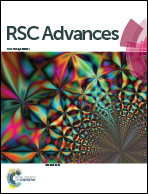Fabrication of superoleophobic surfaces with controllable liquid adhesion from polyelectrolyte multilayer film
Abstract
Superoleophobic surfaces with controllable liquid adhesion were developed on micro/nanostructured aluminum substrates through the deposition of polyelectrolyte multilayer films ion-paired with perfluorooctanoate anions. Various liquids, such as water, glycerol, rapeseed oil, and hexadecane, can be tuned from rolling state to pinned state on the superoleophobic surfaces with increasing number of polyelectrolyte bilayers. The effects of chemical heterogeneity and topographic roughness of polyelectrolyte deposited substrates on liquid adhesion properties were systematically studied. The combined effect of surface chemical defects coupled with the disappearance of nanoflakes and the interconnection of protrusions with the polyelectrolyte deposition led to the surfaces changing from sliding superoleophobicity to sticky superoleophobicity. Our results gave a useful attempt to understand the fabrication principle of preparing superoleophobic surfaces with controllable liquid adhesion. Moreover, the function of controllable liquid adhesion from polyelectrolyte multilayer film could potentially be used in important applications, such as in the selection and transportation of microdroplets.


 Please wait while we load your content...
Please wait while we load your content...